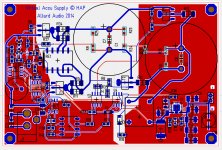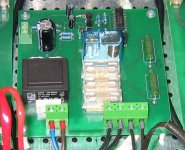I have excellent experience with the positive TPS7Axx and the negative TPS7A33.
Very low noise, very high bandwidth and very good Power supply ripple rejection.
Hans
Nice but not cheap!
With two transistors and some passives you can have something 20 times better in terms of noise, PSRR and Zout. Elvees thread on his denoiser.
With two transistors and some passives you can have something 20 times better in terms of noise, PSRR and Zout. Elvees thread on his denoiser.

Another good tip.
How about your own circuit tricks?
THx-RNMarsh
Thats sounds useful.
To an extent maybe. Inrush also depends on residual core flux from the state of the transformer when it was last turned off. That can make worst case inrush current appear somewhat random.
Nice Zappa. YouTube
John Lee Hooker lived near me in Oakland California. One of my long time favorites blues man. But, it was in New York city where i first heard him live. Played to the very end. Came back to Oakland from playing in Seattle, Washington and died in his sleep of old age. Thats the way to do it.
YouTube
YouTube
YouTube
THx-RNMarsh
John Lee Hooker lived near me in Oakland California. One of my long time favorites blues man. But, it was in New York city where i first heard him live. Played to the very end. Came back to Oakland from playing in Seattle, Washington and died in his sleep of old age. Thats the way to do it.
YouTube
YouTube
YouTube
THx-RNMarsh
Last edited:
Another good tip.
How about your own circuit tricks?
THx-RNMarsh
Before this, it was what Bonsai posted for line level. The old Philips trick to feed opamps through a resistor paired with a sizeable capacitor.
For more sensitive circuits, a low noise opamp fed by a stable voltage. My creativity is more in speakers than in power supply optimalization. That's why I am happy that people like Elvee come up with clever stuff in an area I am not regularly thinking about. I will never go back to another solution. Equal or better performance than an LT3042 at higher currents.
Before this, it was what Bonsai posted for line level. The old Philips trick to feed opamps through a resistor paired with a sizeable capacitor.
For more sensitive circuits, a low noise opamp fed by a stable voltage. My creativity is more in speakers than in power supply optimalization. That's why I am happy that people like Elvee come up with clever stuff in an area I am not regularly thinking about. I will never go back to another solution. Equal or better performance than an LT3042 at higher currents.
Any tricks and tips in loudspeaker performance/systems?
THx-RNMarsh
Actually, the resistor/cap trick works surprisingly well in small signal stuff since the current demand is low (typically <10 mA) and the reg then only sees LF stuff.
One read of Kendall Castor-Perry’s stuff about supply decoupling was enough to tell me it’s a dirty world when it comes to analog supplies. Better to think about the problem differently and to leverage opamp PSRR.
I don’t know what ‘super regs’ bring to the party other than in DAC stages and then they need careful consideration to get the best results IMV. YMMV.
One read of Kendall Castor-Perry’s stuff about supply decoupling was enough to tell me it’s a dirty world when it comes to analog supplies. Better to think about the problem differently and to leverage opamp PSRR.
I don’t know what ‘super regs’ bring to the party other than in DAC stages and then they need careful consideration to get the best results IMV. YMMV.
Actually, the resistor/cap trick works surprisingly well in small signal stuff since the current demand is low (typically <10 mA) and the reg then only sees LF stuff.
One read of Kendall Castor-Perry’s stuff about supply decoupling was enough to tell me it’s a dirty world when it comes to analog supplies. Better to think about the problem differently and to leverage opamp PSRR.
I don’t know what ‘super regs’ bring to the party other than in DAC stages and then they need careful consideration to get the best results IMV. YMMV.
The EMU 1820m fed the op-amps, except maybe the headphone driver, through an RC like you mention.
Nice Zappa. YouTube
John Lee Hooker lived near me in Oakland California. One of my long time favorites blues man. But, it was in New York city where i first heard him live. Played to the very end. Came back to Oakland from playing in Seattle, Washington and died in his sleep of old age. Thats the way to do it.
YouTube
YouTube
YouTube
THx-RNMarsh
Nice!
Scott, I must say I have no clue what so ever what you opamp designer people are stuffing into dill critters etc., so I wonder for instance how large are the transistors in terms of physical size and/or power handling around the input/feedback node stage in opamp's comparing to discrete's like say perhaps BC550/560 or other small signal bjt's, or fet's, next I wonder do you opamp designer guys consider the Lavardin stuff when looking at optimizing the input/feedback stage, am considering now mainly parts oriented towards audio use.
By comparison very small, less that 10sq. mils in the 90's now I'm not sure how small the latest processes are. The thermal stuff is easier than you think due to the close coupling and known geometry. The brilliant Alberto Bilotti solved the thermal problem in closed form so if simple symmetry is not possible his solution can be used to minimize thermal effects by arranging the locations of devices. RCA also did their own analysis for one of their early video matrix encoders.
The end result is that the thermal issues can be reduced to a minor issue, and yes I have had to spin mask sets to fix a few chips for this problem.
The other problem is the finite resistance of the very thin aluminum interconnects, supply routing and ground starring was a problem before we had parasitic extraction. The aluminum has an ~3000ppm/degree TC so when you are making a chip with pin programmable gains you have to be very careful.
Any tricks and tips in loudspeaker performance/systems?
THx-RNMarsh
I will start posting under my own name before too long and then I hope to show some.
One thing to note is that enclosures hardly vibrate because of pressure differentials. It's reaction forces. Another thing to note is that the more a loudspeaker behaves like a true point source, the better the stereo imaging is, and the less dependant it becomes from placement.
It might be quite a fun little project to implement a phase locked loop in software, on a uC, using integer arithmetic. Once you've got that, it would be a relatively low cost addition to independently control (phase at turn-on) and (phase at turn-off). Then you could create the best case or the worst case transformer residual core flux, by setting the turn-off phase angle just right.Job for a uC and a Triac in my book!
I always turn my big transformers on through a 10 Ohm NTC (Ametherm) which then gets shorted out after a few hundred ms by a relay. The caps charging up are also nasty.
I started to play with a controller plus trial solution but never too’ it any further. Maybe something for the future.
There was a plot somewhere (Rod Elliot ?) showing 200A peaks on a big linear supply for the first few cycles.
(I use an ARM uC for all this stuff - LPC1114 SMD version 28 pin https://www.nxp.com/docs/en/data-sheet/LPC111X.pdf)
I started to play with a controller plus trial solution but never too’ it any further. Maybe something for the future.
There was a plot somewhere (Rod Elliot ?) showing 200A peaks on a big linear supply for the first few cycles.
(I use an ARM uC for all this stuff - LPC1114 SMD version 28 pin https://www.nxp.com/docs/en/data-sheet/LPC111X.pdf)
Last edited:
Pretty easy to get 60-80 amps peak inrush current on a big toroid and a big cap bank with no suppression. The wires jump in the conduit in our lab without the inrush boards in place.
I will start posting under my own name before too long and then I hope to show some.
One thing to note is that enclosures hardly vibrate because of pressure differentials. It's reaction forces. Another thing to note is that the more a loudspeaker behaves like a true point source, the better the stereo imaging is, and the less dependant it becomes from placement.
Cabasse, Triangle or Focal? I always liked the Focal stuff!
For a transimpedance Head Amp I'm using a two step power supply, an external 5V USB battery power pack, followed by a low noise LT6234 on board regulator, one for each channel.
For my DAC, Preamp and Phono preamp I'm using a three stage power supply scheme, where I start with a Wall Wart SMPS.
Next step is a "Virtual Accu Supply" consisting of switches loading caps, see image below.
C1 is loaded with SW closed, then SW opens disconnecting C1 from the input, and C2 is loaded from C1 by closing SW1.
SW1 opens and SW closes again and so on at a rate of a very low 10Hz, below the audio range.
Steering of the Mosfet switches is performed with a small PIC12C uController that also prevents large inrush currents at start up.
The third stage are on board controllers.
It's quite a bit, but I just liked to bring this idea to life as a technical challenge and it works already perfectly full time for 5 years.
Replacing the VAS by real batteries gives no noticeable difference in sound and also the noise from the DAC, Preamp and Phono amp show no single sign of the Wall Wart switching frequency, just as with batteries.
Hans


For my DAC, Preamp and Phono preamp I'm using a three stage power supply scheme, where I start with a Wall Wart SMPS.
Next step is a "Virtual Accu Supply" consisting of switches loading caps, see image below.
C1 is loaded with SW closed, then SW opens disconnecting C1 from the input, and C2 is loaded from C1 by closing SW1.
SW1 opens and SW closes again and so on at a rate of a very low 10Hz, below the audio range.
Steering of the Mosfet switches is performed with a small PIC12C uController that also prevents large inrush currents at start up.
The third stage are on board controllers.
It's quite a bit, but I just liked to bring this idea to life as a technical challenge and it works already perfectly full time for 5 years.
Replacing the VAS by real batteries gives no noticeable difference in sound and also the noise from the DAC, Preamp and Phono amp show no single sign of the Wall Wart switching frequency, just as with batteries.
Hans


- Status
- Not open for further replies.
- Home
- Member Areas
- The Lounge
- John Curl's Blowtorch preamplifier part IV
